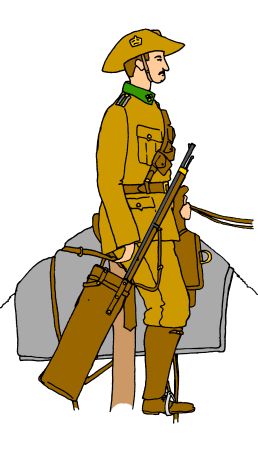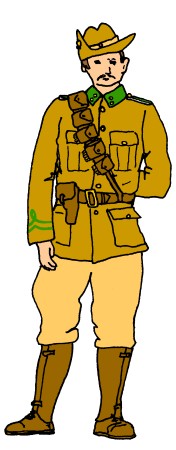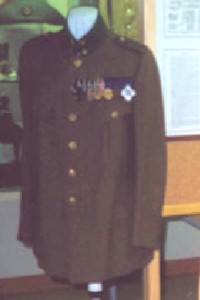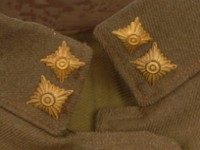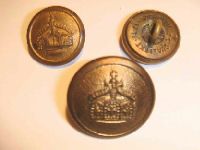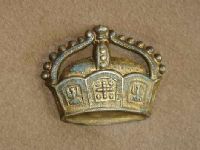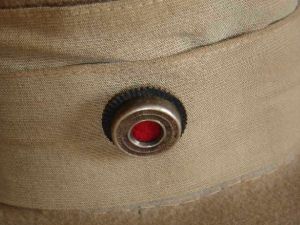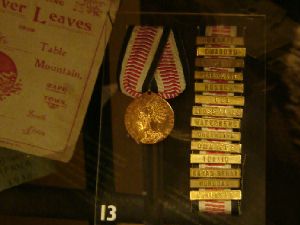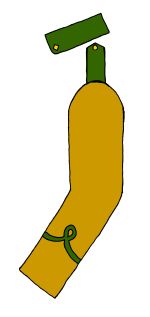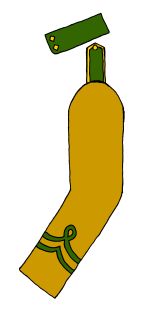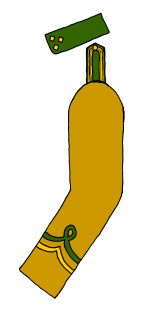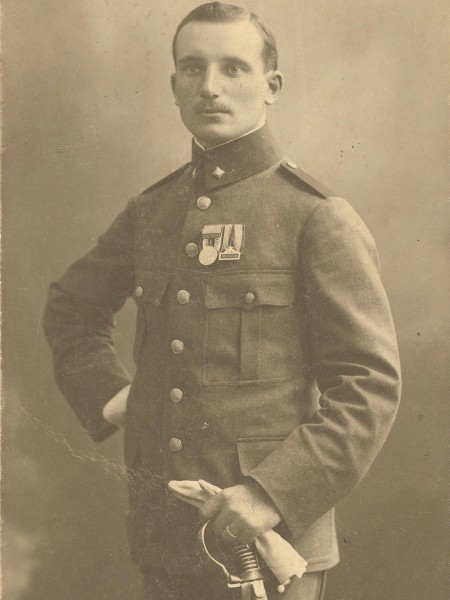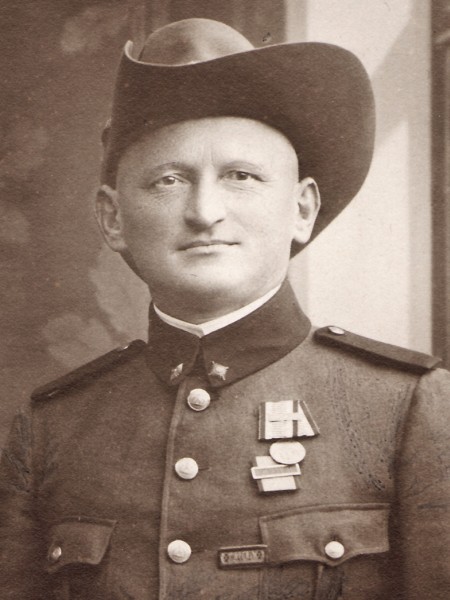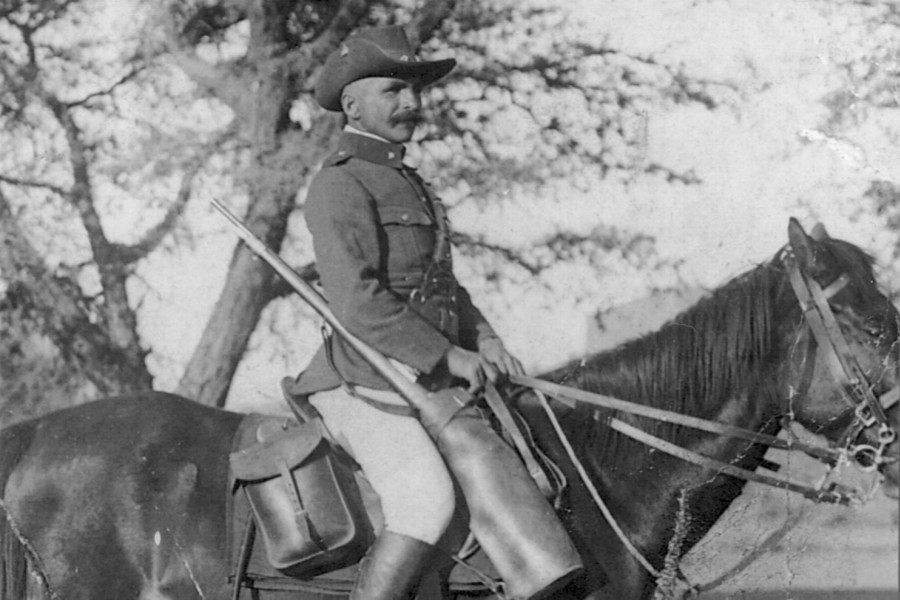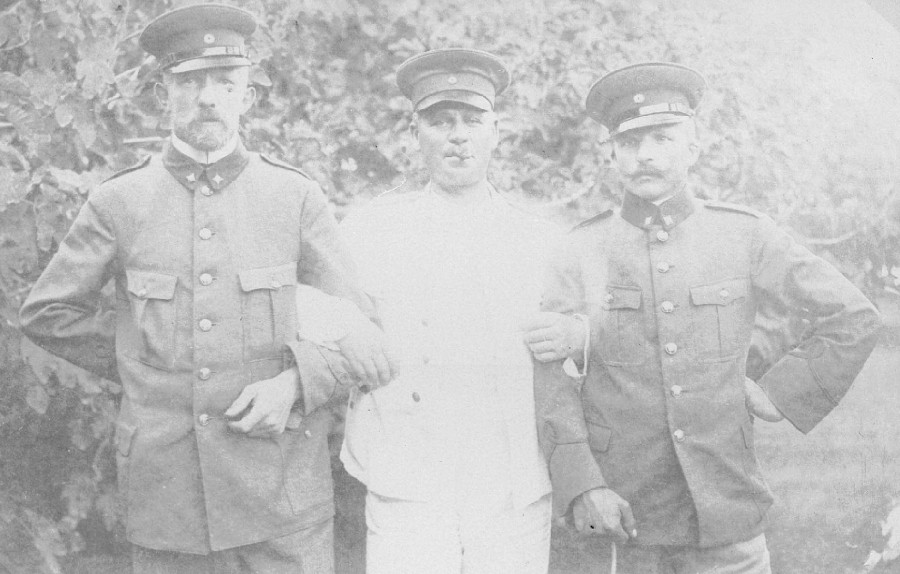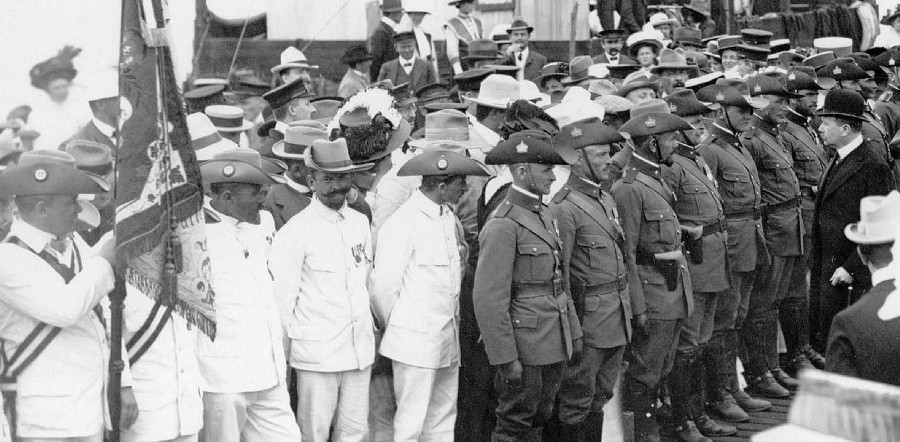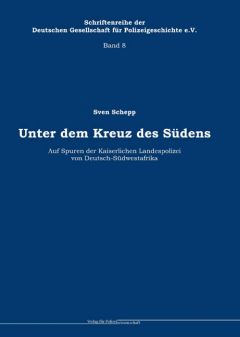| The
first Landespolizei, formed in 1905 wore
Schutztruppe Uniforms
with Police Insignia. On 28th September 1907 a new dark
khaki uniform was authorised for the Landespolizei.
Dark Khaki Tunic
The new tunic was authorised in the same style as the
Schutztruppe 1896 Khaki
Uniform but in a distinctive khaki brown, much darker
than Schutztruppe uniforms. It had green shoulder
straps and a green stand and fall collar. There were two slightly
sloped pleated breast pockets and two straight unpleated hip
pockets. Although the regulations stated that the
Landespolizei uniform would be the same design as the
Schutztruppe uniform the pockets of all the Landespolizei
tunics I have seen in period photographs and modern
collections have pointed pocket flaps, whereas the
Schutztruppe's were usually cut straight. There were six buttons down
the front of the tunic, one on each pocket and two smaller ones holding the
shoulder straps. All buttons were in yellow metal with the
imperial crown. As with Schutztruppe uniforms, Landespolizei
officers often wore tunics with slight variations in cut due
to private tailoring.
Insignia
Rank insignia was shown in the form of
lace on the shoulder straps, pips on the collar and green looped
bars on the cuffs, although the cuff insignia was often omitted
(see below for full rank insignia details).
No specialist insignia has been noted.
Trousers
Trousers were in matching dark khaki and were authorised to
be piped down the outside seam in green. Riding breeches
were in brown corduroy but lighter shades are commonly seen
in period photographs.
Greatcoat
The
Prussian Cavalry other ranks greatcoat in pale grey (see
Schutztruppe Greatcoats) was authorised with
Landespolizei insignia- green shoulder straps (with rank
insignia) and yellow metal
buttons bearing the imperial crown.
Litewka Tunic
From 1907
Schutztruppe Kord Litewkas
were authorised
with Landespolizei insignia- green shoulder straps and rank pips
on the collar. They do not seem to have been commonly worn,
though at least one photograph taken in 1913 shows a
Polizeisergeant wearing a 1899 Schutztruppe cloth Litewka
with Landespolizei insingia.
Tropical
Uniform
Both khaki and white uniforms
were authorised for wear by the Landespolizei in the style
of the 1896 Schutztruppe
Uniform but without
Schutztruppe piping and insignia. Instead Landespolizei
green shoulder straps, yellow metal buttons and rank collar
pips were worn (see
Landespolizei
Tropical Uniforms Page).
Südwester Hat
A new type of Südwester hat was introduced for the
Landespolizei along with the 1907 uniform. It was made from brown
felt with a hatband of a paler shade of khaki and a small
imperial cockade at the front. The brim of the hat was held up on the
right-hand side
with a brass imperial crown badge. Differences in the style and
size of the crown were common due to privately variations.
Field Cap
A Peaked Field Cap was worn by
all ranks when not wearing the Südwester. It was of a matching
dark khaki colour to the 1907 uniform with hatband and piping in green and
chinstrap and peak in black leather. The chinstrap was held at
either side with a small yellow metallic button bearing the
imperial crown. A small imperial cockade
was worn in the centre of the hatband. Like most German peaked
caps it was worn with a wire retaining loop that held the
shape of the top of the hat.
Footwear
Brown leather boots were worn with
matching gaiters by most Landespolizei. , although some photographs show
the trousers being worn loose over the boots.
Gloves
Brown leather gloves were authorised but period photographs
show white gloves were also worn on peacetime duties.
Personal Equipment
The standard personal equipment worn
by the Landespolizei was in brown leather. It consisted of a bandolier
with eight removable ammunition pouches (each
holding a clip of five rounds, the shells of which protruded
from the lower side of the pouch) worn over the left shoulder
and attached to a waist belt on the right hand side, Sam Brown style.
Some photographs
show the bandolier worn over the opposite shoulder, several
photographs show the upper pouches worn without bullets in them
and at least one photograph shows the ammunition pouches worn
upside down on the bandolier. These variations were presumably
for ease and comfort and were not regulation. The bandolier and
belt were could be worn without ammunition pouches when not on
active duty. Both the bandolier with ammunition pouches and the
belt could also be worn separately of each other.
Some photographs
show the Landespolizei wearing Schutztruppe equipment and ammunition pouches
(see
Schutztruppe
Mounted Equipment Page).
Weapons
The Landespolizei were armed mainly with
pistols. The 1883 Reichsrevolver and the Roth-Sauer Pistol were
both in common use, the Luger P08 was also issued sometime after
1912. Rifles were also carried. Records in "Unter
dem Kreuz des Südens" show the Landespolizei had a
collection of different types of standard German rifles in
their possesion- G71, G88, K88, G98, G98S and varieties of K98.
They also had small supplies of S71/84, S98 and kS98 bayonets in
their arsenals although these were not standard issue to the
Landespolizei on duty.
Unlike in the Schutztruppe,
ranks as low as Sergeant were permitted to carry a sword.
The sword issued from 1905 was similar to the Prussian light
cavalry sabre. There were two types of sword knot worn, the
"Faustriemen" for a Polizei-Sergeant and the "Portepee" for
ranks above Sergeant, though Sergeants who had been of
Portepee rank in previous services (such the Schutztruppe)
were entitled to continue wearing a Portepee. From 1907 the
Landespolizei Faustriemen consisted of a brown leather strap and a green knot
with a white fringe.
The Landespolizei Portepee was also carried on a leather
strap often with yellow metallic
lace along its length and had a closed acorn knot of white
metallic thread often with a green upper part. It seems
from period photographs that several variations on these
themes were actually worn. Some Faustriemen and Portepee
knots had a green and white flecked stem above the knot. From an order of 24th
June 1909, the sword was no longer worn on active service.
Recommended External Link- Article on
Traditionsverband on
Landespolizei Swords
Civilian Attire
The
Landespolizei did not have a home uniform for wear in
Germany. In fact, they were not authorised to wear their
Landespolizei uniforms in Germany except for special
occasions such as the Kaiser's birthday parades. Usually when
home in Germany they wore civilian attire. Civilian attire was
also worn when onboard foreign ships en route to Africa,
when on undercover duty and by the senior police officers ("Polizeiassistenten").
Uniforms of Schutztruppe
Officers and Officials attached to the Landespolizei
In addition to police
personnel, there were about a dozen Schutztruppe Officers
attached to the Landespolizei to oversee military matters and
training. These officers wore Schutztruppe uniform and rank
insignia. There were also three junior
paymasters ("Unterzahlmeister") attached to the
Landespolizei, they also wore the uniform of a colonial paymaster
rather than that of the Landespolizei.
The Last Landespolizei Uniforms
In August 1914 the majority of the Landespolizei were incorporated into the
Schutztruppe and issued Schutztruppe uniforms. Only a few remained to serve as
police in their 1907 uniforms in the North of the colony until the surrender of
German South West Africa in July 1915. The Landespolizei uniforms
were
however worn after August 1914 by other units- the
South African Free Corps
Boer rebels that sided with the Schutztruppe of German South
West Africa in 1914, the Afghan Mission of 1916 led by Oskar Ritter von Niedermayer and from 1929 up until the Second World War by the
mounted police of Bremen with whom the tradition of the old
Landespolizei was entrusted.
| |
|
|
| |
The Illustrations
Figure 1
is based on a photograph of Diensttuende
Polizeiwachtmeister Hermann Kratz of the South West
African Landespolizei taken while on service in the
Kalahari desert, mounted
on a camel. He wears the 1907 dark khaki uniform. His rank is shown as a Diensttuende Polizeiwachtmeister with three brass pips on
the collar and a thick band of lace edging the green shoulder
strap (see below for rank insignia details). He wears dark khaki
riding breeches, also probably privately tailored.
His Südwester hat has
a larger than usual imperial crown badge as was often seen on officers
privately tailored hats.
He wears the standard Sam Brown
belt over his left shoulder and carries a Mauser G98 rifle
slung in a rifle bucket attached to
the camel saddle. Both the Schutztruppe and
Landespolizei made use of numbers of imported camels in the Northern
and Eastern deserts of German South West Africa.
| |
Hermann Kratz
(1879-1955) was born in Nieder-Ohmen and joined the
115th Hessian Life Guard Regt ("Leibgarde-Infanterie-Regiment
(1. Großherzoglich Hessisches) Nr.115") in 1899. In 1901 he
volunteered for the South West African Schutztruppe, was
promoted through NCO ranks in the 3. and 9. Kompanie and
transferred to the Landespolizei as a Polizeisergeant in
1905. Further promotion followed to
Polizeiwachtmeister in 1908 and Diensttuende
Polizeiwachtmeister in 1911. During the First World War he
served in the Schutztruppe again, this time as Vize-Feldwebel
der Landwehr. After the surrender of South West Africa he
was a Prisoner of War in the camp at Aus for several months
before being released on parole. He returned to Germany
after the war and became an innkeeper.
Recommended External Link -
Oberhessische Zeitung |
Figure 2
is based on a photograph of a Polizeiwachtmeister
of the South West
African Landespolizei
taken in Windhoek in 1914. This uniform is similar to that of the
previous figure except that he wears the rank insignia of a
Wachtmeister (two collar
pips, a thin strip of gold coloured lace around the shoulder straps
and two bars of green cuff lace) and carries the Sam
Brown style ammunition belt over his right shoulder.
In this example as on several others, only the lower three
pouches can be seen to contain ammunition, this may have been
for comfort and to
facilitate firing a rifle from the right shoulder. He carries a
Roth-Sauer pistol in a holster on his belt.
His corduroy riding breeches were either manufactured in a
lighter shade (variations due to private tailoring were common) or have faded badly in the sunlight.
Figure 3
is based on a photograph of a
Polizeisergeant of the South West
African Landespolizei.
This figure shows the rear of the 1907 uniform. His riding
breeches are of a shade matching the tunic. Note the
attachment of the Sam Brown belt again with a Roth-Sauer
Pistol in the holster.
Figure 4
is based on a photograph of a Polizeisergeant
of the South West
African Landespolizei.
This Sergeant wears the 1907 uniform with matching trousers, piped in
green and the peaked field cap with hatband and piping also in green. He
carries a sword with a Faustriemen sword knot, with a green knot and a
white fringe. Note the non-regulation white
gloves and the impressive medal display. |
|
| |
|
|
|
|
